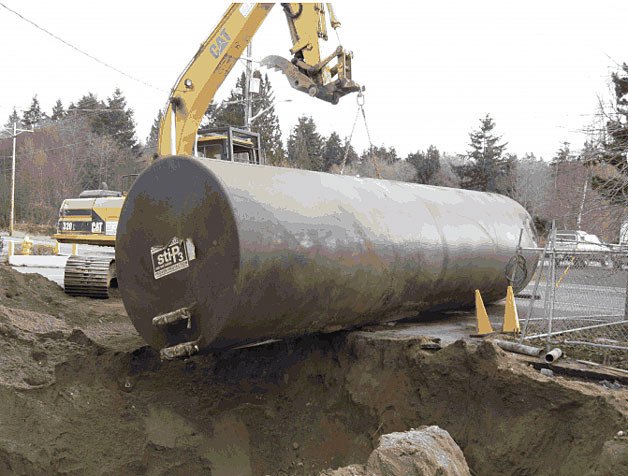An estimated 7,000 gallons of gasoline that spilled from a broken fuel tank eight years ago is now threatening Freeland’s water supply, state officials have confirmed.
According to Louise Bardy, supervisor of the state Department of Ecology’s voluntary Clean up Program, recent monitoring has revealed contamination in the area’s sea-level aquifer, about 100 feet below the surface.
The spill also appears to be traveling, very slowly, toward the Freeland Sewer and Water District’s wells, which are about 1,900 feet away and provide water to about 90 commercial business and nearly 400 residences.
Bardy believes the danger is “moderate” but it’s not clear just how far the “plume” has spread.
“We don’t know,” she said. “We’re trying to find that out.”
Ecology officials plan to attend the district’s monthly meeting next week and give the commissioners a presentation, outlining what happened, what’s been done so far and future monitoring plans.
The meeting will be held at 5:50 p.m. Monday, Aug. 12, at Whidbey Water Services, 5421 Woodard Ave. in Freeland.
According to agency documents, the spill occurred in 2005 at what was formerly Whidbey Marine and Auto Supply on Main Street. The store, which also sold fuel, was in operation from 1967 until 2008.
Records show then owner Marty Winn submitted a fuel inventory reconciliation report that indicated a “7,000-gallon release of gasoline.”
Winn could not be reached for comment. His phone number is not listed and contact information provided by ecology officials was no longer valid.
Ecology Spokesman Larry Altose said the leak came from a two-inch hole in one of the tanks. It is believed to have been caused by a metal dipstick used to check tank levels.
It’s dropped down a port from above and, in older tanks, falls with enough force that over time it will penetrate the bottom skin of the tank. 
He said it’s unknown just how long fuel was leaking but speculated it wasn’t long.
Following Winn’s fuel discrepancy report, he began participating in the state’s voluntary clean up program. Efforts were undertaken to recover the spilled fuel but less than one-third —about 2,000 gallons — was retrieved.
“They recovered what was recoverable,” Altose said.
Monitoring was continued by Winn’s hired consulting firm, Farallon Consulting. Last year, data revealed the gasoline had reached Freeland’s sea-level aquifer.
Alerted to the progression, ecology officials made the decision about two months ago to notify water district commissioners and employees.
The news came as something of a shock.
“It was totally out of our radar,” Commissioner Marilynn Abrahamson said.
The commissioners didn’t know about the ongoing monitoring or even the original problem, she said.
“Concerned? I’m concerned!” Abrahamson said. “This is absolutely huge and nobody knows about it.”
Andy Campbell, manager for the water district, said he doesn’t believe the issue is an emergency yet but that the news from ecology was “surprising.”
“I’m glad they finally brought us into the conversation,” Campbell said.
The district and neighboring property owners were alerted after the spill occurred. It was believed, however, the spill was of minimal threat.
Experts thought the perched aquifer, which goes down about 60 feet, would contain most of the fuel and that it would move north towards Holmes Harbor.
But monitoring data showed the fuel turned southeast instead, indicating that aquifer water moves in a different direction than surface water, said Diane Escobedo, ecology’s site manager for the former marine supply store.
“We still don’t know how far that contamination goes,” Escobedo said.
The situation may not be a crisis yet, said Campbell, but he is concerned. If the spill reaches the district’s wells, it will be a big problem.
“We have millions of dollars invested in our well field,” Campbell said. “We don’t want to lose that obviously; it would be catastrophic.”
Bardy also made clear that district wells aren’t the only ones at risk. A Harbor Hill well could also be affected but she couldn’t say at the time how many homes it services.
Island County Public Health Hydrogeologist Doug Kelly said additional monitoring of the situation is necessary but doubts well contamination is a serious threat.
Fuel leaks underground don’t spread fast and have limited lifespans, he said.
“They grow for a while and then sputter to a halt,” Kelly said. “Then they begin to shrink and go away.”
Soil acts as a natural filter and a process known as natural attenuation gradually breaks down the contaminants over time, he said.
“The odds of this getting to Freeland’s wells is almost nonexistent,” Kelly said.
But the state agency isn’t taking any chances.
“Right now we don’t know where the contamination ends,” Altose said.
Additional monitoring wells are planned so experts can track the plumes progress. They are expensive, however, and Winn’s insurance policy is nearing its limit.
Altose and Bardy both said Winn was concerned about the problem and is cooperating, but finances may become a problem at some point.


